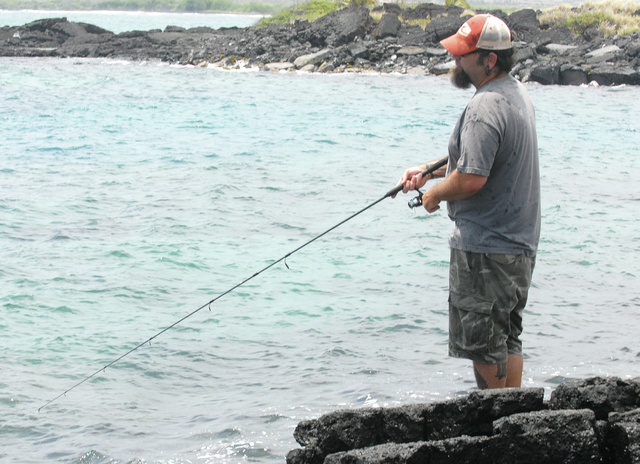KAILUA-KONA — It’s an age-old design going back to ancient hooks carved in bone, when primitive man sought to assure that every fish he hooked was one he would land.
But its time just might be pau.
At least that’s the message behind the Barbless Circle Hook Project, a state and federally backed initiative to get anglers to grab a pair of pliers and smash down the barb on their fishing gear. The modification creates a fishing device that won’t remain stuck for long periods in the jaws and throat of animals it was never intended to hook.
“All we’re asking for is the try,” said Kurt Kawamoto, a biologist with the NOAA Pacific Islands Fisheries Science Center in Honolulu. “We’re not trying to beat anyone over the head.”
Barbless hooks can be self-shed by the lunkers that break the angler’s line. And they’re easier for responders to remove from the mouths of turtles and monk seals. Countless other animals — as well as fish that aren’t wanted for food or bait — could be saved by the simple technique, said Kawamoto.
The state has no estimate on how many fishermen are smashing down their barbs with pliers, according to Department of Land and Natural Resources spokesman Dan Dennison. However, half of the contestants in last Sunday’s 13th annual Tokunaga Ulua Challenge fishing tournament in Hilo registered to fish barbless.
A contestant took first place in the omilu division with a 20-pounder caught on a barbless hook, and barbless fishermen regularly do well in the contest.
You could easily call Kawamoto the state’s biggest advocate for barbless hook fishing. Besides working for the past dozen years with fishermen and tournament organizers to promote the method, he’s also conducted experiments with both barbed and barbless hooks to see how fish retention is affected.
“From those experiments and from a practical perspective using hooks of my own and talking with other fishermen, it doesn’t seem to make a difference,” said Kawamoto. “You catch some and you lose some, whether you have barbs or not.”
It’s the shape of the hook rather than the barb that helps keep the bait and fish on, he said.
The biologist has found an increasingly receptive audience for his soft-sell of the barbless technique over a dozen years of the project, with tournament organizers setting up new barbless fishing categories and asking him to come down and speak to fishermen.
Count tournament organizer Michael Tokunaga among the converted. His tournament has grown from 136 entrants its first year to 637 this year. Tokunaga said he’d like to see barbless competition increase by at least another 25 percent.
“This is for conservation and releasing unwanted catches. It’s just a way of fishing smart,” he said in a press release prepared by DLNR. “When you catch a fish, the hook is normally in the side of the mouth. The barb has nothing to do with it in my opinion.”
West Hawaii angler Abel Vanderbosch isn’t buying, though. As he dipped his line in the Pacific on Wednesday, he said the barbless hooks don’t measure up.
“They are good for catch and release, but not for catch,” he said.
Kawamoto said that changing a mindset is a long process.
“It’s coming along,” he said. “We’ve convinced a lot of people but it takes time.”
Deb Wickham, operations manager for The Marine Mammal Center’s Hawaiian monk seal hospital Ke Kai Ola, has seen the damage from hooks firsthand. Barbless hooks are definitely easier to remove from marine mammals, she said, and they can save a trip to the emergency room for a human.



